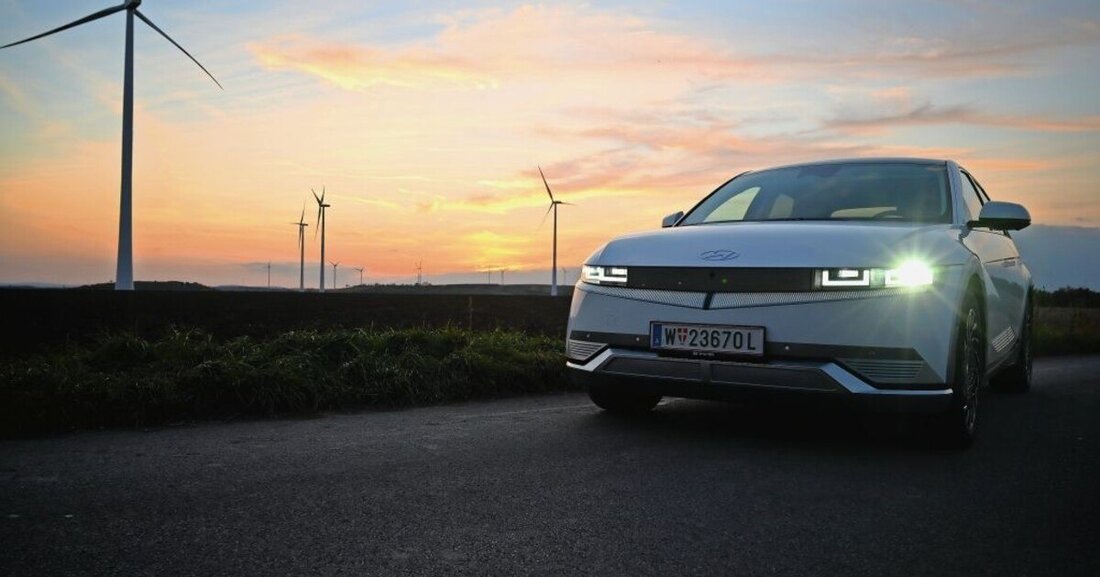Hyundai annoys the Porsche
Hyundai is doing a lot right with the new Ioniq 5. Just looking at the price list makes you dizzy.

Hyundai annoys the Porsche
The new Hyundai Ioniq 5 is a real eye-catcher: whether in the city, in the country, on the highway: everyone who catches a glimpse of the LED headlights or notices the futuristic, block-like shape of the Ioniq 5 takes a closer look. The word futuristic has never been more appropriate for a production model. The hard edges hit into the metal, the angular lights (pixel design) like something out of a 1980s video game and the cool Atlas White make it clear: the Hyundai is not an ordinary man who wants to swim along in the gray everyday life of automobiles. He is the Freddy Mercury of cars: an exceptional talent, a trendsetter, come to permanently change the automotive world.
Technology & Design
Why are we so full of praise right from the start? Because the Hyundai Ioniq 5 is not a dazzler, not a normal car that became an electric car through compromises. The Ioniq 5 is the first model that is based on the new Electric Global Modular Platform (E-GMP) and is therefore tailored exclusively to the e-mobility of today and tomorrow. What is special is the 400 V and 800 V charging infrastructure used. And so the Hyundai offers comparable technology to the Porsche Taycan, but is many times more expensive than the E-Korean. A 72.6 kW battery was used in our rear-wheel drive test model. Depending on the rim dimensions, Hyundai specifies the range as 481 km (with 19-inch tires) or 451 km (with 20-inch wheels). According to the data sheet, the average consumption per 100 km is 16.8 kWh. In our test, consumption was slightly higher at around 20 kWh. The charging times are impressive: With the Type 2 charging cable, the Ioniq 5 should be fully charged in just over 6.5 hours. With a CCS fast charging plug at 50 kW, the charging time drops - from ten to 80 percent charge - to just over an hour. And if you get a CCS charger with 350 kW, the Korean will charge its batteries in the same spectrum within 17 minutes. Impressive – nothing less.
reality
The data sheet promises 160 kW (218 HP) and a torque of 350 Newton meters. A top speed of 185 km/h should be possible. Typically for Stromer, the acceleration capacity - especially from a standstill - is impressive: from zero to 100 km/h it should be 7.4 seconds. It feels like it's significantly less. The starting pressure - especially in sport mode - is awesome. Even real horsepower monsters from the super sports guard can't keep up with it in the first few meters. However, the slump occurs again and the sprint slows down noticeably from around 70 km/h. But let's talk about the range: If you drive economically, foresight and use the comfort features that make driving more enjoyable (handlebar and seat heating, air conditioning, sound system), 300 to 350 km are possible in everyday life. The higher the proportion of motorway, the lower the range and the more city traffic, the higher. Of course, because as soon as you brake, the electric vehicle recuperates and recharges the battery. Hyundai has integrated the i-Pedal for this purpose. This increases the recuperation power to a maximum. If you take your foot off the accelerator, a strong engine brake is immediately applied to ensure maximum reverse charging. The braking force is so strong that the conventional brake is only needed for emergency braking. If you drive with foresight, just using the accelerator pedal is enough. Paired with the Eco mode, this results in a very comfortable, stress-free driving experience. If you let the electric horses gallop, you can feel the almost two tons of dead weight both when turning and braking. The chassis is comfortable, but not buttery smooth. The steering guides the Ioniq 5 precisely and the feedback is correct. Although not harsh, the driver feels enough of the asphalt surface to know what is still possible and what is not. Only the rolling movements could be less.
Space, lots of space
The wheelbase is really long at three meters. Accordingly, the Ioniq 5 drives confidently with the right feeling of space: airy, relaxed, nothing pinches, nothing seems cramped. Smart: The footwell is not separated by center consoles at the front or rear. Even the rear seats are electronically adjustable. The glove compartment is a drawer. And the trunk holds between 531 and 1,591 liters. Only the loading sill has been chosen a little high by the Hyundai engineers for everyday use. The generous turning circle of almost twelve meters is striking in city traffic. Be careful in narrow streets and parking garages. In general, the Ioniq 5 is not exactly ultra-compact with a total length of 4.6 meters and a width of 1.89 meters. Nice: In tight garages, you can drive it out of the parking space using a key - Knight Rider feeling included.
Conclusion: The concept is convincing
All in all, the Ioniq 5 shows that its concept is coherent and practical. With the CUV shape, it is clear and offers space and range. The modern 800 V charging technology is up to date and offers security for the next few years. The cool look, the very good workmanship and the numerous nice details leave Hyundai newcomers amazed. There is already a certain upper class flair. But the price is steep: the list says 58,730 euros. That's a lot of money for an electric vehicle whose residual value is still somewhat questionable.
Our diary of change serves as a platform for car models with alternative drives, for new mobility solutions and business areas as well as mobility reports from everyday life in order to find out how mobility will develop further from 2021.
With kind support from Total Austria

 Suche
Suche
 Mein Konto
Mein Konto